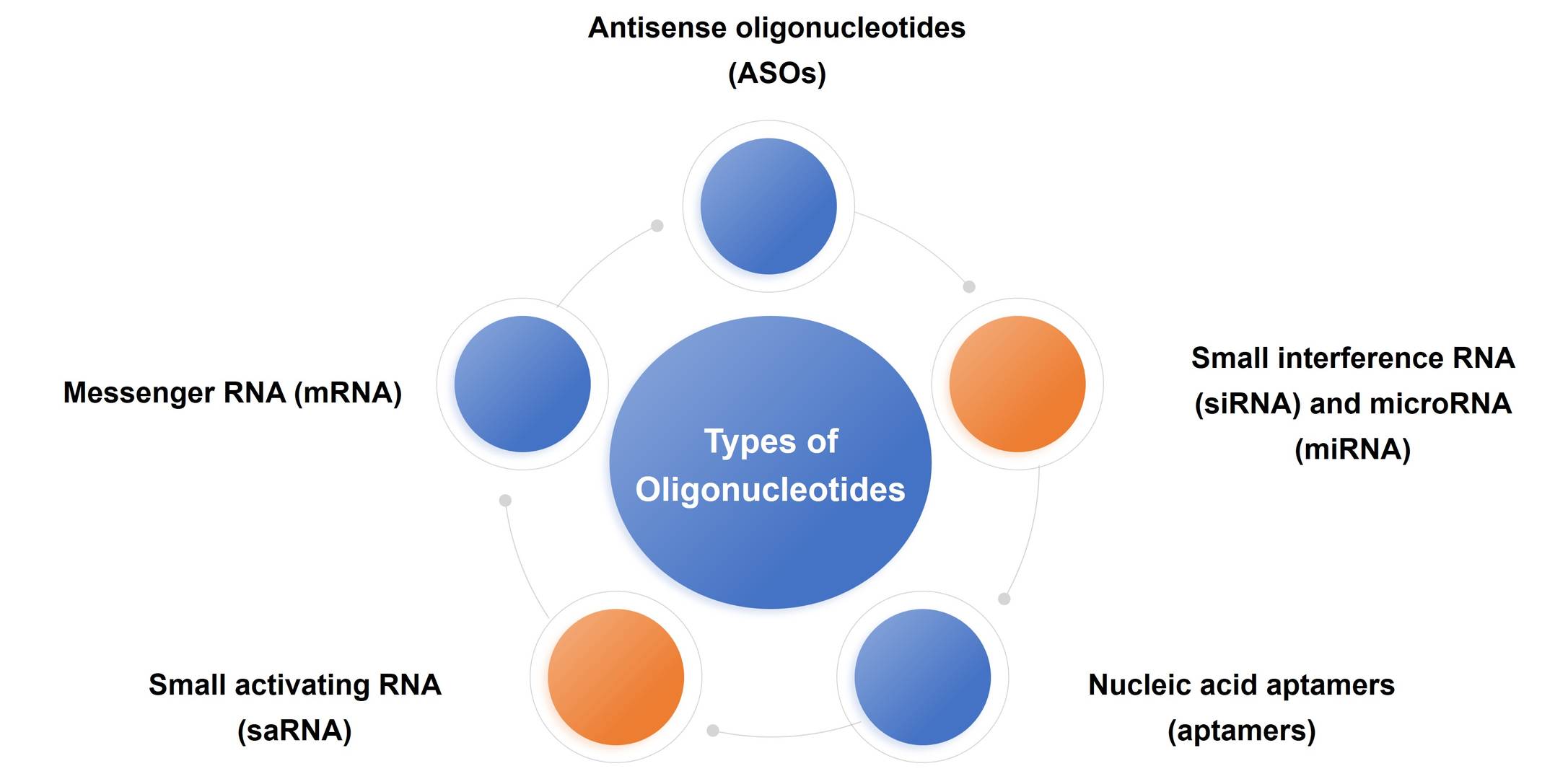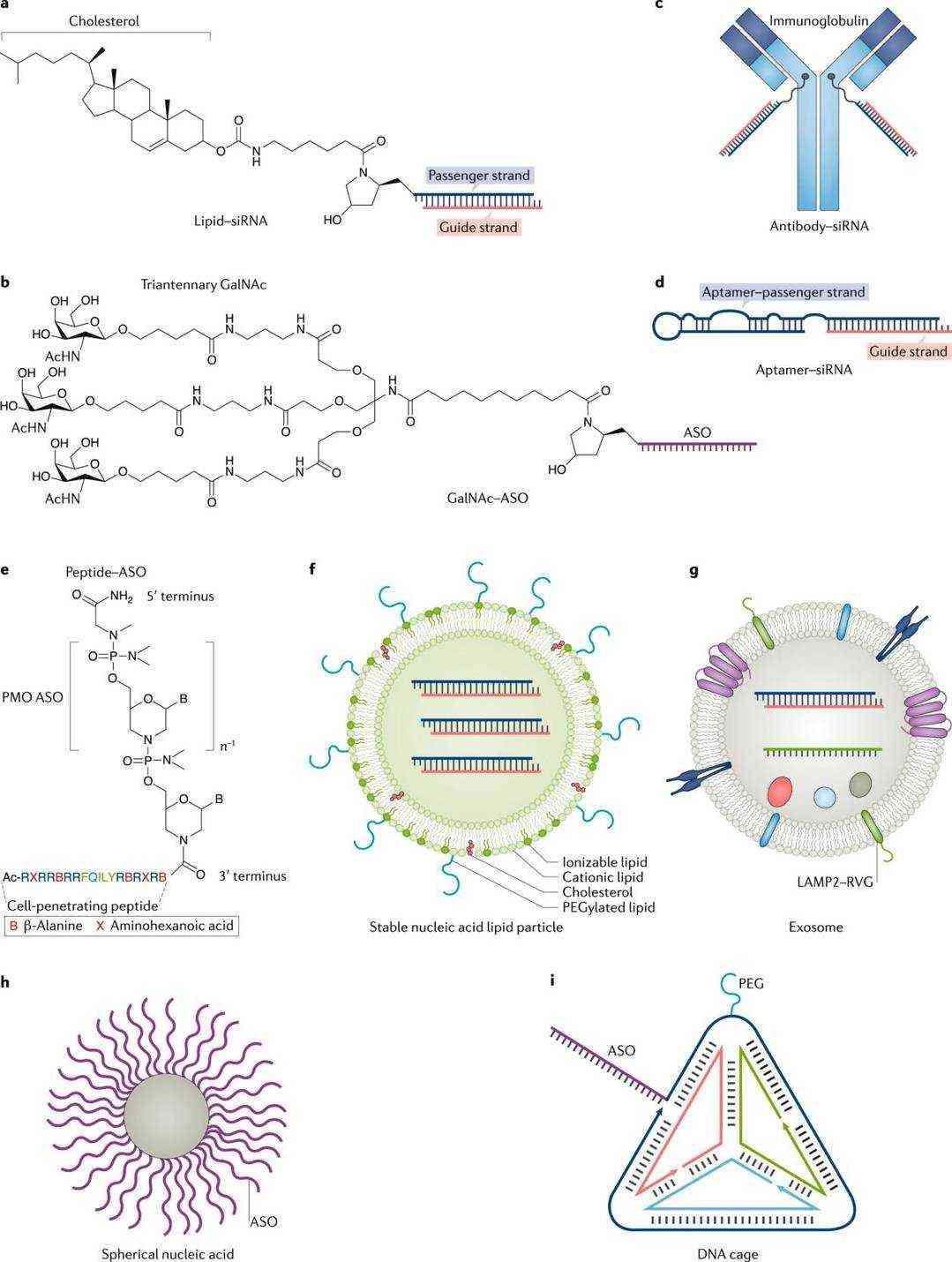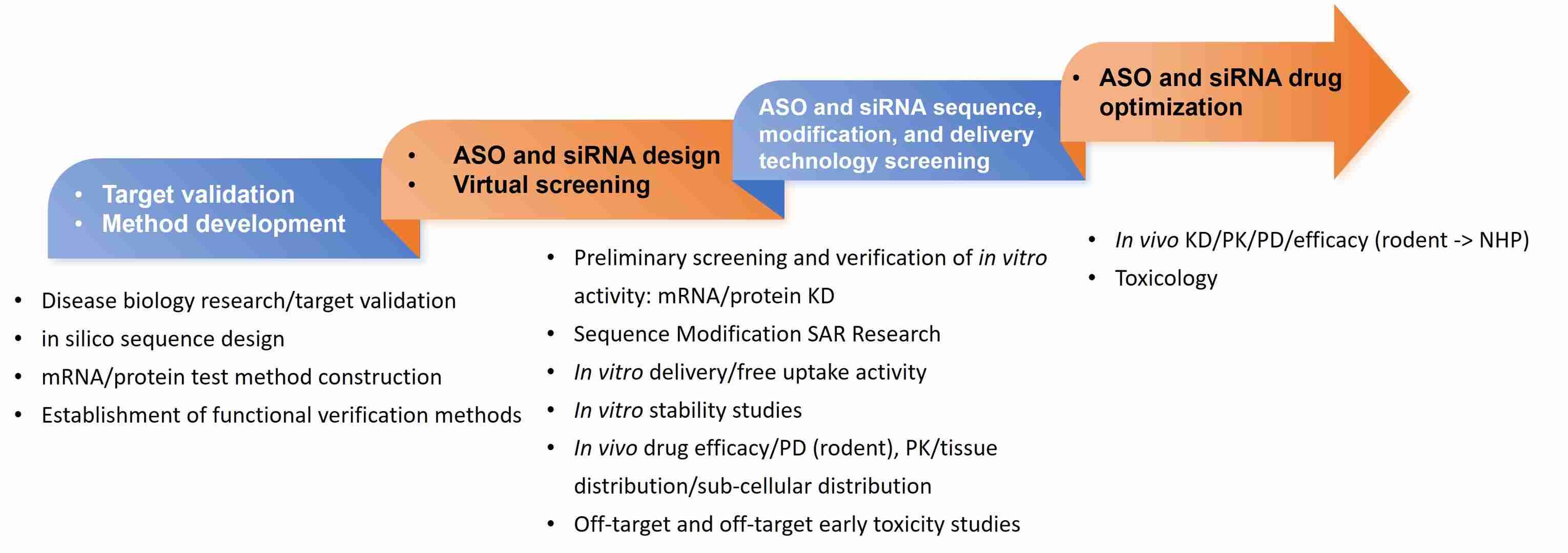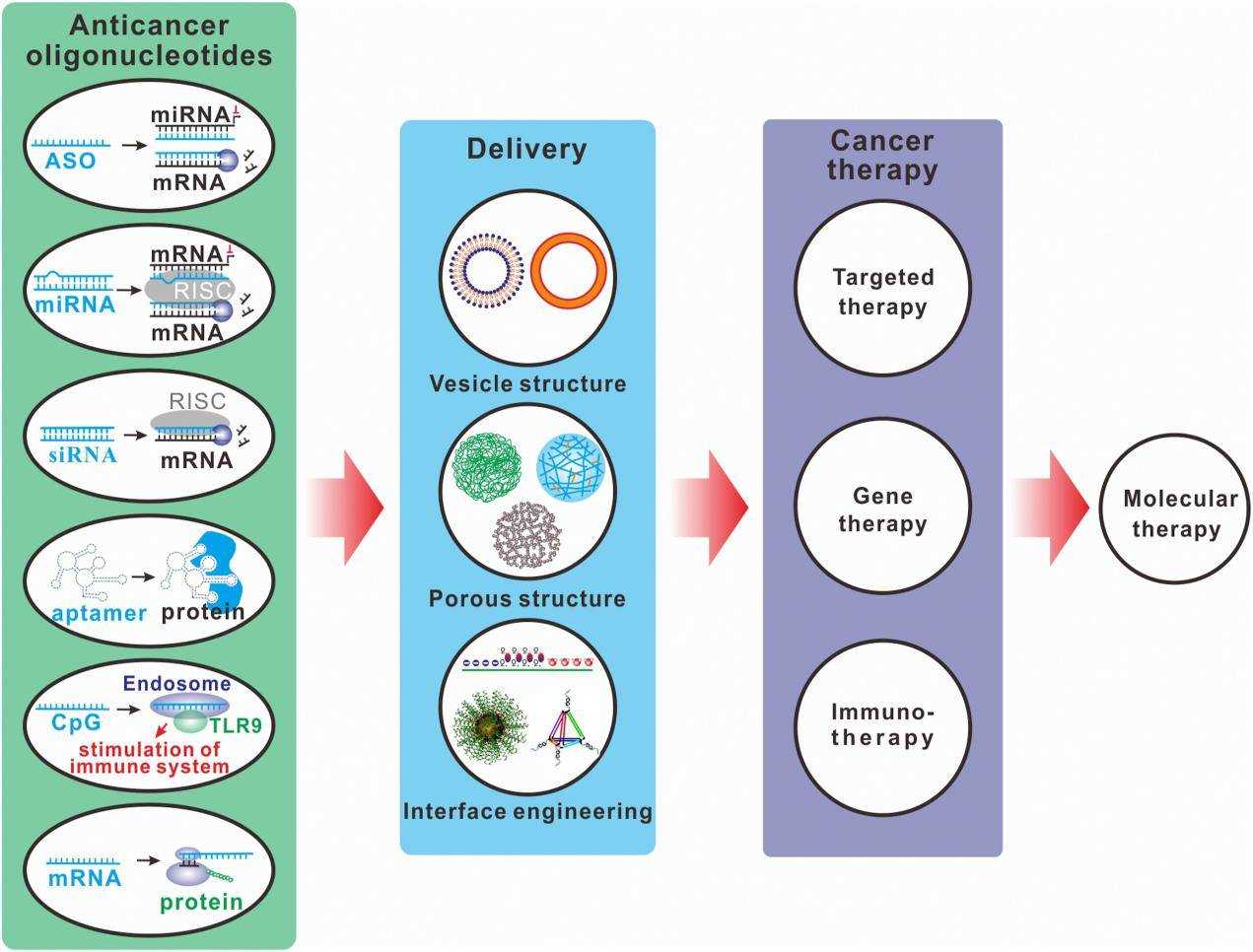Oligonucleotide Drug Delivery Technology for Biologics
Inquiry
Oligonucleotides are used to modulate gene expression through a range of processes, including RNAi, RNase H-mediated cleavage target degradation, splicing regulation, noncoding RNA inhibition, gene activation, and programmed gene editing. Our approaches to achieve efficient oligonucleotide delivery, particularly to extrahepatic tissues, include chemical modification, bioconjugation, and the use of nanocarriers. CD Formulation can provide you with oligonucleotide drug development services to meet the different requirements with the support of our advanced oligonucleotide drug delivery technology.
Classification and Advantages of Oligonucleotides
Oligonucleotide drugs are composed of 12 to 30 chemically synthesized short-chain RNA or DNA. They can bind to target RNA through the Watson-Crick base pairing principle, use endogenous nucleases to degrade target RNA, or regulate RNA splicing and translation through stereo blocking ribosome mechanism, so as to achieve the purpose of treating diseases. Oligonucleotide drugs are mainly divided into antisense oligonucleotide drugs (ASOs), small interfering RNA drugs (siRNA), nucleic acid aptamers (aptamers), messenger RNA (mRNA) and small activating RNA (saRNA).
 Fig.1 Types of oligonucleotides. (CD Formulation)
Fig.1 Types of oligonucleotides. (CD Formulation)
Oligonucleotide drugs are widely used in the field of biomedicine because of their following significant advantages.
- Strong specificity. Oligonucleotide drugs are artificially designed based on target RNA, so they have clear targets and strong target specificity.
- Simple design and short development cycle. Preclinical research and development of oligonucleotide drugs first involves determining the gene sequence, rationally designing disease genes, and targeting gene silencing. Therefore, blind development can be avoided, and research and development time can be saved to a large extent.
- Rich targets. Oligonucleotide drugs treat from the post-transcriptional level and can make breakthroughs for special targets that have therapeutic effects on some protein targets and are expected to overcome genetic diseases for which there are no drugs.
Clinical Applications of Oligonucleotide Drugs
The ability of oligonucleotides to modulate any therapeutic target by modulating its expression level would make almost any therapeutic target a potential drug. Continuous breakthroughs and innovations in the application and technology of oligonucleotide drugs will help the indications of oligonucleotide drugs, including tumors, rare diseases, viral diseases, kidney diseases, cardiovascular diseases, inflammatory diseases, metabolic diseases, etc.
Tumor Therapy
Oligonucleotide drug nanocarriers should have the characteristics of immune evasion, target cell or tissue delivery ability, high cell entry efficiency, etc. Anticancer oligonucleotide drugs can safely and efficiently deliver oligonucleotides to the target site to supplement missing anti-tumor genes and silence tumor-driving genes to treat cancer.
Oligonucleotide Therapeutics in Metabolic Diseases
Oligonucleotide therapeutic approaches can manipulate gene expression through a range of different biological processes, including RNA interference (RNAi), RNase H-mediated target degradation, splicing regulation, noncoding RNA inhibition and gene activation, and are used to treat chronic metabolic diseases (such as dyslipidemia, cardiovascular disease, diabetes), rare genetic metabolic diseases, etc.
Explore Our Oligonucleotide-based Platforms
CD Formulation relies on our advanced design concept and oligonucleotide drug delivery technology to construct oligonucleotide-based platforms, including antisense oligonucleotides, RNA-precision duplex silencers, microRNA inhibition, and transcriptional gene activation.
Antisense Oligonucleotides Platform
Antisense oligonucleotides are synthetic single-stranded nucleic acid polymers of small nucleotides with a variety of chemical compositions that can be used to regulate gene expression through various mechanisms.
RNAi-Precision Duplex Silencers
siRNA molecules are the effector molecules of RNAi, and we have designed a variety of variants of the prototype siRNA, including Dicer substrate siRNA, small internal fragment siRNA, self-delivery siRNA (asymmetric and hydrophobic), single-stranded siRNA, and bivalent siRNA.
microRNA Inhibition
MicroRNAs (miRNAs) are endogenous RNAi triggers that guide RISC to target sequences where they initiate gene silencing. Our approach to inhibiting miRNAs is to use steric blocking ASOs to inhibit specific miRNA regulatory interactions by masking target sequences on mRNA transcripts.
Transcriptional Gene Activation
Based on our advanced strategy for specific gene activation, we exploit naturally occurring nonproductive alternative splicing events that lead to premature stop codon generation and transcript degradation via nonsense-mediated decay.
Our Oligonucleotide Drug Delivery Strategies Based on Nanocarriers
Advances in nanotechnology and materials science offer advantages and potential solutions for oligonucleotide drug delivery, especially for the requirements of crossing biological barriers and transmembrane intracellular delivery. The main advantages of nanoparticle delivery systems include the customized optimization of nanoparticle biophysical (such as size, shape, and chemical/material composition) and biological (such as targeting ligand functionalization) properties, thereby achieving highly customized delivery platforms. Various nanocarriers for nucleic acid drug delivery include lipid complexes and liposomes, exosomes, etc. CD Formulation uses lipid formulations for oligonucleotide delivery and emerging new methods, including endogenous exosomes, SNAs, and self-assembling DNA nanostructures. Our oligonucleotide drug delivery strategies for biologics include but are not limited to lipoplexes and liposomes, exosomes, spherical nucleic acids, DNA nanostructures, and stimuli-responsive nanotechnology.
Lipoplexes and Liposomes
Lipid formulations can enhance nucleic acid delivery. We mix polyanionic nucleic acid drugs with lipids to form lipoplexes, which causes the nucleic acid to condense into nanoparticles with more favorable surface charges and are large enough to trigger uptake by endocytosis. Liposomes are composed of a lipid bilayer, with the nucleic acid drug residing in the encapsulated aqueous space. Liposomes are usually composed of cationic or fusogenic lipids and cholesterol-PEGylated lipids. Stable nucleic acid-lipid particles are liposomes containing ionizable lipids, phosphatidylcholine, cholesterol, and PEG lipid conjugates.
Exosomes
Exosomes have the following properties for oligonucleotide drug delivery: They are able to cross biological membranes, are non-toxic, have the potential to be produced in an autologous manner, and have inherent pro-regenerative and anti-inflammatory properties that can enhance the efficacy of therapeutic oligonucleotide delivery. Engineered exosomes can deploy combinations of therapeutic and/or targeting moieties.
Spherical Nucleic Acids
The spherical nucleic acid (SNA) approach is a nanoparticle-based delivery strategy. SNA particles consist of a hydrophobic core nanoparticle (including gold, silica, or various other materials) decorated with hydrophilic oligonucleotides (such as ASOs, siRNAs, and immunostimulatory oligonucleotides) densely packed on the SNA surface via thiol bonds.
DNA Nanostructures
DNA nanostructures are used for oligonucleotide delivery. These structures include DNA origami and DNA cages.
Stimuli-responsive Nanotechnology
Stimulus-sensitive, activatable drug delivery nanotechnology is a solution for oligonucleotide delivery. The activatable CPP conjugate consists of an oligonucleotide covalently linked to a peptide folded into a hairpin structure.
 Fig.2 Schematics of various delivery strategies for small interfering RNAs (siRNAs) and antisense oligonucleotides (ASOs). (Thomas C. Roberts, et al. 2020)
Fig.2 Schematics of various delivery strategies for small interfering RNAs (siRNAs) and antisense oligonucleotides (ASOs). (Thomas C. Roberts, et al. 2020)
Highlights of Our Oligonucleotide Drug Delivery Technology
- At our advanced oligonucleotide-based platforms, we have explored different preparation platforms (such as constructing oligonucleotide-based platforms, including antisense oligonucleotides, RNA-precision duplex silencers, microRNA inhibition, and transcriptional gene activation) to tailor oligonucleotide drugs to meet specific therapeutic needs.
- Our technical team has been committed to researching oligonucleotide drug delivery strategies based on nanocarriers to enhance targeting and oligonucleotide drug delivery.
- We are also able to construct oligonucleotide drug delivery systems including modification and synthesis of nucleotide monomers, synthesis of delivery systems, synthesis of oligonucleotides and oligonucleotide conjugates, etc.
Custom Oligonucleotide Drug Delivery Systems
Relying on our oligonucleotide drug delivery technology and nanocarrier platform, CD Formulation has established a relatively complete R&D process for oligonucleotide drugs after years of practical experience. First, we identify and verify the target. We explore targets through disease mechanisms or explore new targets with the help of human genetics and AI technology. After the target is clear, we establish the corresponding screening method. Next, we screen the sequence, modification and delivery technology of nucleotide drugs. Since oligonucleotides are sequence-designed drugs, we generally introduce off-target effect studies in the early stages. Finally, we conduct in vitro free uptake and stability-related studies and later optimize the drug for the pharmacokinetic properties and toxicity of oligonucleotides. We can provide customers with modification and synthesis of nucleotide monomers, synthesis of delivery systems, synthesis of oligonucleotides and oligonucleotide conjugates, etc.
 Fig.3 Our workflow for oligonucleotide drug development. (CD Formulation)
Fig.3 Our workflow for oligonucleotide drug development. (CD Formulation)
Published Data
Technology: Therapeutic oligonucleotide delivery based on several various types of nanocarriers
Journal: Bioactive Materials
IF: 18.0
Published: 2022
Results:
The authors introduced the basis of therapeutic oligonucleotides and the mechanism of action of several typical therapeutic oligonucleotides, and described the obstacles that hinder the clinical transformation of therapeutic oligonucleotides and the research progress of this type of drug. At the same time, the authors summarized the drug delivery of therapeutic oligonucleotides based on several different types of nanocarriers, including lipid-based nanoparticles, polymer nanoparticles, gold nanoparticles, porous nanoparticles, DNA/RNA nanoassemblies, extracellular vesicles, and imaging-guided drug delivery nanoparticles. Nanoparticles can not only protect therapeutic oligonucleotides from nuclease degradation and enhance their tumor accumulation, but also improve the cellular uptake efficiency of therapeutic oligonucleotides and subsequent endosomal escape to increase the therapeutic index. Nanocarrier-based oligonucleotide drug delivery technology provides a practical delivery strategy for effectively delivering therapeutic oligonucleotides to cancer cell targets and promoting their clinical transformation.
 Fig.4 Nanocarrier-based systems for delivery of oligonucleotides for molecular therapy of cancers. (Lei Wu, et al. 2022)
Fig.4 Nanocarrier-based systems for delivery of oligonucleotides for molecular therapy of cancers. (Lei Wu, et al. 2022)
CD Formulation has been actively exploring strategies to improve the targeting capabilities of oligonucleotide drug delivery, such as using genetic modification technology and nanocarrier technology. If you have any questions about our oligonucleotide drug delivery for biologics, please do not hesitate to contact us.
References
- Thomas C. Roberts, Robert Langer, Matthew J. A. Wood. Advances in oligonucleotide drug delivery. Nature Reviews Drug Discovery. 2020,19, 673-694.
- Lei Wu, Wenhui Zhou, Lihua Lin, et al. Delivery of therapeutic oligonucleotides in nanoscale. Bioactive Materials. 2022,7: 292-323.
How It Works
STEP 2
We'll email you to provide your quote and confirm order details if applicable.
STEP 3
Execute the project with real-time communication, and deliver the final report promptly.
Related Services


 Fig.1 Types of oligonucleotides. (CD Formulation)
Fig.1 Types of oligonucleotides. (CD Formulation) Fig.2 Schematics of various delivery strategies for small interfering RNAs (siRNAs) and antisense oligonucleotides (ASOs). (Thomas C. Roberts, et al. 2020)
Fig.2 Schematics of various delivery strategies for small interfering RNAs (siRNAs) and antisense oligonucleotides (ASOs). (Thomas C. Roberts, et al. 2020) Fig.3 Our workflow for oligonucleotide drug development. (CD Formulation)
Fig.3 Our workflow for oligonucleotide drug development. (CD Formulation) Fig.4 Nanocarrier-based systems for delivery of oligonucleotides for molecular therapy of cancers. (Lei Wu, et al. 2022)
Fig.4 Nanocarrier-based systems for delivery of oligonucleotides for molecular therapy of cancers. (Lei Wu, et al. 2022)
